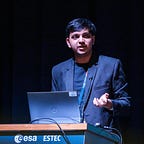A look at the TeamIndus spacecraft that will land on the Moon
An overview of the components and their function
TeamIndus is launching its spacecraft to the Moon in 2020. This will be the first time any private entity attempts to land on the lunar surface. We have built our spacecraft to survive the landing. Here’s an overview of our spacecraft.
The spacecraft has 3 major systems:
- Spacecraft Bus: The spacecraft bus consists of the structural skeleton, thermal and propulsion systems.
- Avionics: This system houses the on-board computer, power and communications systems.
- Payloads: Our rover ECA, the Japanese rover Sorato (which we are also carrying) and all the Lab2Moon experiments are the major payloads onboard the spacecraft.
#1: The structure and thermal systems of the spacecraft
The spacecraft has optical solar reflectors and heat shields to keep itself cool. The lander structure is designed to withstand the impact forces during the launch and landing. The landing gear uses crushable aluminium honeycomb to absorb the impact forces during touchdown on the Moon.
The spacecraft design thus ensures the safety of the payloads and all the subsystems in the spacecraft. The maximum diameter of the spacecraft is decided by the launch vehicle.
The interface ring as shown in the diagram below will be used to connect to the rocket for launch.
#2: Propulsion system
The primary engine on the spacecraft is a liquid rocket engine with a thrust capability of 440 N for major maneuvers. It is accompanied by sixteen small 22 N thrusters for finer orbital maneuvers and directional control.
The propellant is pushed by the two helium-pressurized tanks onboard the spacecraft. Hydrazine is used as the fuel combined with Nitrogen Tetroxide as the oxidizer. The propulsion is controlled by the Heater Propulsion Card (HPC) onboard the spacecraft.
The propulsion system is designed such that it meets the requirements of soft-landing on the Moon while catering to other mission scenarios.
#3: Power & Communication systems
The three solar panels on the spacecraft are the primary power source, generating 235 W. A 24 Ah Lithium-ion battery is also present for additional power. Spacecraft communication with the control center is handled via the radio S-band and X-band.
S-band is the same channel used by NASA for communication with the International Space Station (ISS). The X-band is used for high frequency transmission as in air traffic control and defense applications. A TM/TC card is used for processing both the data that is sent and received.
#4: The on-board computer (OBC)
The most important job of the On-Board Computer (OBC) is to act as a guidance, navigation and control system (GNC) for the entire mission duration. The OBC orchestrates the command+telemetry data processing and related operations. The lunar descent is controlled through the GNC using data from a host of sensors.
#5: Payloads
The TeamIndus spacecraft is carrying two of the world’s lightest rovers to the lunar surface. The Indian rover is the ECA a.k.a. Ek Choti si Asha (Hindi for ‘A small hope’), while the Japanese rover is Sorato. The lander will be used to communicate with both the rovers.
For Science
Three science experiments are onboard the spacecraft. INFN has their MoonLIGHT-2 instrument that will use lunar ranging techniques to perform General Relativity tests. The Indian Institute of Astrophysics has their LUCI ultra-violet telescope onboard, while the InSTEM institute has an experiment studying regeneration of planarial worms in microgravity.
Conclusion
This was an overview of the TeamIndus spacecraft. Check out our tech blog section where we dive deeper into each aspect of our mission engineering.
